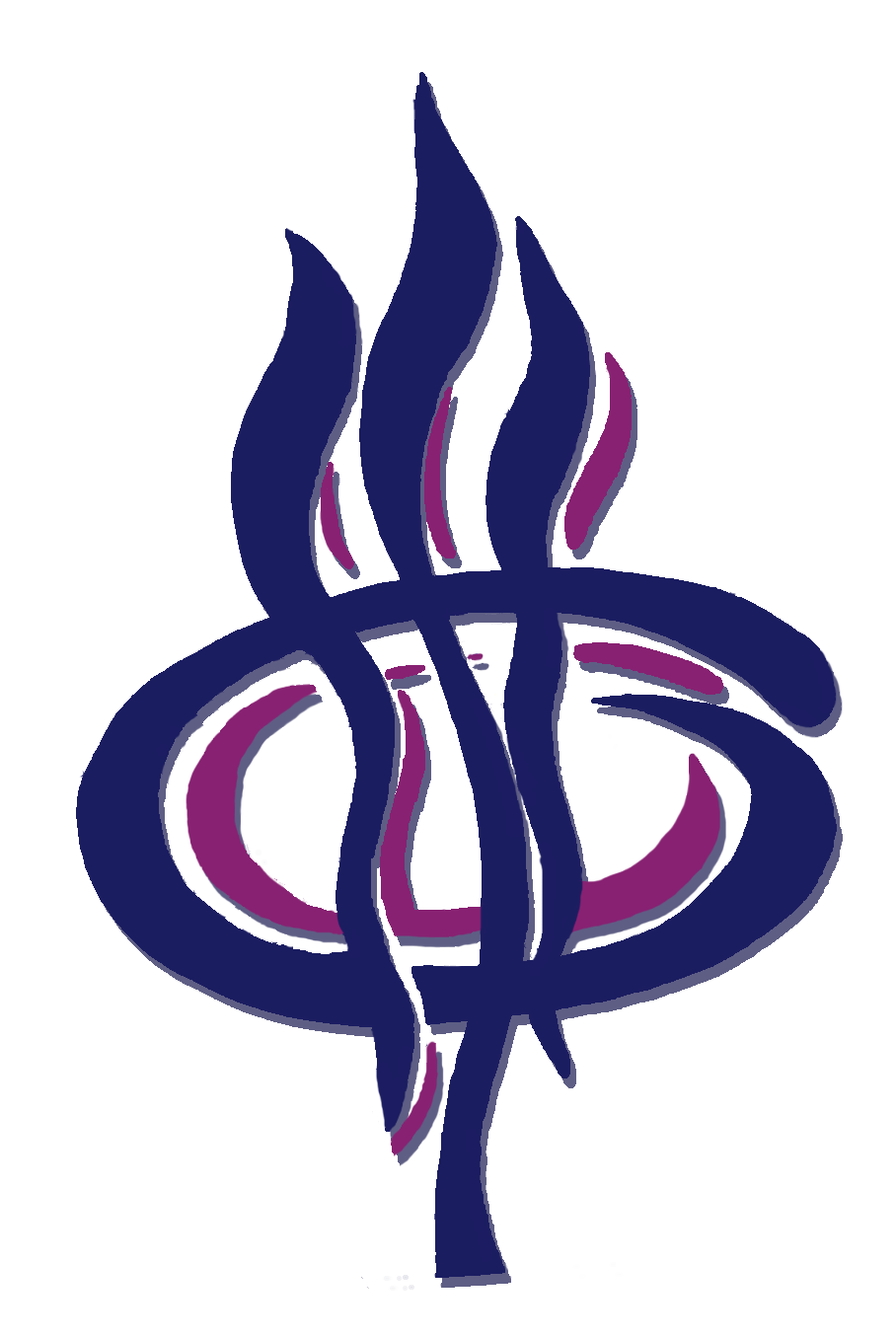Journalistic Media as а Modelling Instance of Reality. A practical application of Bernd Mahr’s theory of models to Bulgarian media in the period after the fall of Communism (1989)
Bistra Velichkova
Sofia University St. Kliment Ohridski, Sofia, Bulgaria
In this paper we investigate to what extent the reality that is reported on the pages of newspapers is a model for the media and to what extent the media themselves are becoming a modelling instance that constructs the reality. We look at the problem in the context of the Bulgarian media after the fall of Communism (1989). We apply the theory of models of Bernd Mahr (‘On the Epistemology of Models’ (2011) by analyzing two of the most influential national daily newspapers in the period after 1989 – Duma and Demokracia.
Key words: model; media; reality; reporting; Duma; Demokracia
В настоящата статия изследваме до каква степен реалността, която отразяват медиите на страниците на вестниците, е модел за медиите и до каква степен самите медии се превръщат в моделираща инстанция, която конструира действителността. По-конкретно разглеждаме проблема в контекста на медиите в България след падането на Комунизма (1989). За да дадем отговор на изследователския въпрос, прилагаме теорията на моделите на немския математик Бернд Мар (представена в статията „Върху епистемологията на моделите“ (2011). Прилагаме неговата теория, изследвайки два от най-влиятелните национални всекидневници в периода след 1989 г. – в. „Дума“ и в. „Демокрация“.
Ключови думи: модел; медии; действителност; медийно отразяване; Дума; Демокрация
Introduction
In this paper we investigate to what extent the reality that is reported on the pages of newspapers is a model for the media and to what extent the media themselves are becoming a modelling instance that constructs the reality. More specifically, we look at the problem in the context of Bulgarian media after the fall of Communism (1989) – a period of big historical significance known as “The Transition” or “Prehod” (Bulgarian). To answer the question stated we apply the theory of models and, in particular, the theory of the German mathematician Bernd Mahr, as presented in his paper ‘On the Epistemology of Models’ (2011). According to Mahr (a) a model is modelled by the subject to which it is a model and (b) a model is something that is perceived as a model. Therefore, everything can be a model of something if it is perceived in such a way.
We apply Mahr’s theory to two of the most influential national newspapers during the period after 1989 – Duma (Word) and Demokracia (Democracy). The former used to represent the interests of the Bulgarian Socialist Party (BSP), while the latter was the newspaper of the newly formed democratic party – the Union of Democratic Forces (UDF). Our results closely confirm the predictions of the theory: the media are indeed an accurate model of reality. At the same time, as Mahr foresees, the act of reporting itself transforms the media into a modelling institution that dictates the way in which historical events are interpreted. They influence the construction of models of thought according to which people start to perceive reality.
We stress that while applications of the theory of models to journalistic media may already exist in published literature, to the best of our knowledge, this is the first such application to Bulgarian media. The latter is the main novelty of this work.
I. Model Theory
Model theory can be applied in all fields of science – mathematics, social sciences, etc. The basic principle of Model Theory is that the mathematical truth, as all truths, is relative. A statement can be right or wrong, according to how and where it is interpreted (Weiss, D’Mello 1997: 3). In the Oxford dictionary, there are several definitions of a model: 1) a standard or example for imitation or comparison; 2) a representation, generally in miniature, to show the construction or appearance of something (For example – the model of a ship is a smaller representation of the real ship); 3) a person or thing that serves as a subject for an artist, sculptor, writer, etc. ; 4) a person whose profession is posing for artists or photographers (For example – The woman is a model of the artist who wants to paint a picture with an image of a beautiful woman); 5) a style or design of a particular product (For example – new model of a car) (Oxford Dictionary 2018).
In many cases a model is a simplified representation of the original. The model of something is used for the easier understanding of the original. For example, the model of an atom, made of plastic, helps students in school for the better and easier understanding of the structure of the atom, which is not visible without microscope. The model is a representation of the original.
On the other hand, a model is perceived also as an instrument which is used for different purposes. For example, when we would like to draw clouds, the real clouds in the sky become the model of our painting. In the same way, a model of society is made in order to analyze how society functions. In fiction, there can be a certain interpretation of a book, which can be seen as a model of the society in which we are living today (For example, the Bulgarian novel Bai Ganio or the American book Great Gatsby).
We have decided to analyze the issue through the Model theory of Bernd Mahr, which is based on the epistemic pattern of model-being and four interdependent relationships. We are interested how a new theory from recent years (2011), framed in theoretical structure and figure, works in practice, in the field of media. There is much research on the journalistic media analyzed through the theory of Structuralism. However, to the best of our knowledge there has not been much research on the media as a modelling instance through Bernd Mahr’s theory.
II. Bernd Mahr’s Theory (2011)
In his paper ‘On the Epistemology of Models’ (2011) Bernd Mahr explains the fundamentals and nature of the models. He says that ontologically, ‘a model is something as which something is being conceived of as a model’ (Mahr 2011: 249). On the other hand, Mahr says that ‘the epistemology of models concerns what is conceived of and what is implied if something is being conceived of as a model’ (Mahr 2011: 249). Also, the structure of a model shows a pattern of contextual relationships. It forms a model itself: the model of model-being. To be a model means to be accepted as a model of something. Bernd Mahr claims that in all models there is ‘one and the same characteristic structure of contextual relationships on which the judgments on model-being rest’ (Mahr 2011: 254). He calls this structure the epistemic pattern of model-being. It encompasses four interdependent relationships which the author explains in the following figure (Mahr 2011: 255):
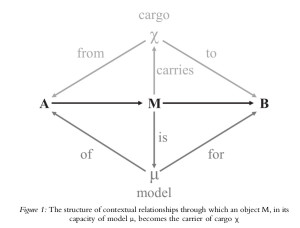
Figure 1
On the figure we can see that the object (M) is a model-object (μ) of A and for B. Here, what is important is the way something has been perceived as a model. For example, if an artist wants to make a painting with a beautiful human body he starts to paint a woman that he perceives as beautiful. In this way the woman becomes a model of a beautiful body (A), but she is also a model for the artist (B). In this case the object (M) is a model-object (μ) of A and for B. The object (M) should bring certain qualities to the cargo (Х), which is the meaning of the model. It means that the model itself has some prerequisites because of which it is chosen as a model. Bernd Mahr calls this “a matrix”: The beautiful woman (M) is a model-object (μ) of a beautiful body (A) and for the artist (B). In this example, we can clearly see who is the modelling instance. This is the artist who decides what is suitable for him for a model for his painting.
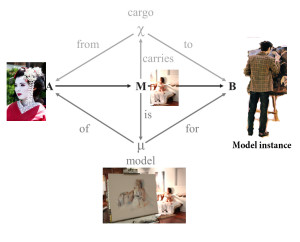
Figure 2
The modelling instance is the artist, who tends to see a certain object as a model. The works of art in drawing, literature and cinema represent a model of the reality. These works are inspired by the reality and try to present it in their own understanding. Books and movies are giving a certain interpretation of what is reality. Products of art are model of reality, but they are also a modelling instance, because they give interpretation of what reality is. Analogically, we can apply the same idea to the journalistic media for which reality serves as a model. However, while they represent the model of reality into a media product, at some point the media themselves turn into a modelling instance for the same reality.
III. Reality as a model for the media or the media as a modelling instance of reality
If we apply Bernd Mahr’s theory from Figure 1, in the field of the media, we can make the following assumption: The media product (M) is a model-object (μ) of reality (A) – the way it is presented/reported and for reality (B) – the way it is perceived/viewpoint. On one hand, the media product is a representation of the “original” – the reality, but on the other, the media are also a modelling instance showing people how they should perceive and think about the reality. The media product is a sort of a “second hand” reality, an interpreted reality. In this way, the media create a model for what is reality, an explanation of its own.
Reporting on certain events on televisions, radios, newspapers, etc., the media present a condensed summary of the reality. That’s why the media play a crucial role in the way people perceive and think about events that are happening in the social and political life in their countries. This is the main issue we are analyzing in this paper. As a modelling instance of reality, the media create articles and reports whose main purpose is to interpret events in clearer and simpler terms to the people. Through this simplification, the media form a “second” reality, which is refracted through the prism of the specific media.
IV. What is “reality” for the media
Reality in the media is viewed as a series of events in different fields. Professor Snejana Popova says that “An event is locating time in space. Along with this, it has its own continuation and relations with other event”(Попова 2002: 50). In all aspects – journalistic, historical, personal, time has always been constructed in terms of events. The media represent a social instrument for “synchronization” of consciousness and the production of “common time” (Попова 2002: 15). During the years after the fall of Communism in 1989, the media have faced a hard time when it comes to reporting events objectively. Every newspaper has reported political and social events with their own interpretation and viewpoint. In this way a very subjective “common time” is produced by the media. Of course, in democratic regimes in the presence of freedom of press this subjectivity should not be a problem. However, in an unstable society such as the Bulgarian one during the transition period after 1989, the lack of objective reporting hides serious risks for manipulation and confusion about what is truth and what is a lie. By reporting on events, the media represent a second reality, where a “refracted” life is presented. This is what Paul Ricœur calls “prefiguration” (Dowling 2011: 3). If we follow his theory, we can conclude that every story is a prefigured reality. Probably, in this context, we should not be surprised by the high level of subjectivity in the media and the lack of transparency about truth. The media summarize events from the near past in order to interpret them to people. However, this process of summarizing, of reporting and explaining is also a way to give certain information from a certain point of view. The events are reported in a way which aims to influence a particular way of thinking. If we are aware of the fact that the media are a “second reality”, we should not be so critical of the subjective reporting. However, the problem comes from the fact that many of the media are advertising themselves as the ones who report on reality in the most objective way. In this way they mislead their audiences.
Based on our theoretical statements about the media and the reporting of reality, we can try to see in practice to what extent the reality that is reported on the pages of newspapers is a model for the media and to what extent the media themselves are becoming a modelling instance that constructs the reality. We can do this by applying the Model theory of Bernd Mahr. More specifically his theory of the epistemic pattern of model-being and four interdependent relationships, presented in Figure 1. So, according to Mahr’s figure, we can say that: The media (M) are a model-object (μ) of reality (A) – the way it is presented/reported, but also for reality (B) – the way it is perceived and interpreted by the media (B).
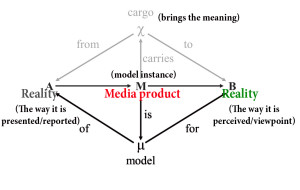
Figure 3
In order to see in practice if our assumption in Figure 3 works, we will analyze two Bulgarian newspapers from the beginning of the 1990s. The two newspapers are completely different in the ideology and policy they follow when they report events. The newspapers are Duma (Word) and Demokracia (Democracy) that appeared in the year of 1990. They were two of the biggest and most influential national newspapers at that time.
V. The newspapers Duma (Word) and Demokracia (Democracy) as a modelling instance of reality in the beginning of the Transition period after 1989 in Bulgaria
The first issue of Duma newspaper (Word) appeared on 4th of April 1990. Duma is a successor of the newspapers Rabotnik (Worker), Socialist (Socialist), Rabotnicheski vestnik (Newspaper of the workers), as well as of the newspaper Rabotnichesko delo (Working Class Affairs) – one of the biggest and most influential newspapers during the Socialist regime (1945–1989). As a successor of all of these media, Duma was perceived as the medium of the Bulgarian Socialist Party (BSP). Before 1989, Rabotnichesko delo was the paper of the Bulgarian Communist Party (BCP). Duma proclaims openly its political side on the first page of each edition: “A daily newspaper of the Bulgarian Socialist Party”.
In the first years of Democracy in Bulgaria, after 1989, a lot of new newspapers started to appear, as alternatives to the most popular socialist party media Rabotnichesko delo. One of the first democratic newspapers was Demokracia (Democracy). Its first issue appeared on 12th of February 1990. The newspaper became famous as the medium of the newly formed democratic party – Union of Democratic Forces (UDF). Similarly to Duma, on the first page it claimed: “A daily newspaper of the Union of Democratic Forces”.
As publicly proclaimed media of the two political parties, the two newspapers logically defended the interests of these parties, while reporting on the events right after 1990. That is why a comparison between these two newspapers, which are completely different in their ideology, is a good example of how the same events can be presented in two different ways and perspectives by two different media. In order to see in practice how the same event is reported in different ways (by Duma and Demokracia), we are going to choose an event which is of great importance to Bulgarian political history in the beginning of the so called Transition period after 1990. This event is the first democratic general elections after the fall of the Communism. The first round of the elections, for the 7th Grand National Assembly in Bulgaria, was held on 10th of June 1990. The second round was on 17th of June 1990.
In the days before the elections, both newspapers published numerous articles and news on the topic. On 8th of June 1990, the title on the 1st page of “Duma” is: “Inspiring meeting of BSP called for national unity”. Under the title we see a big photo of the meeting of the Bulgarian Socialist Party (BSP) in the center of Sofia. The article under this title presents the speech of Andrey Lukanov (Prime Minister of the BSP, after the elections) and Alexander Lilov (BSP party leader). The lead of the article says the following: “In 60 days – from 1 January to 1 June 1990 – 24 804 new socialists have joined the party”.
On the very same day (8th June 1990) the leading article on the 1st page of Demokracia was with the following headline: “Chances for Bulgaria. Speech of Zhelio Zhelev, presented on the meeting of the United Democratic Forces (UDF) on 7 June 1990”. The paper gives detailed information about the meeting of UDF.
On 8 June, on the 2nd page of Duma, we can read the speeches of A. Lukanov and Al. Lilov. The title of Lilov’s speech is: “The socialists today are the most self-critical and noble party”; The title of Lukanov’s speech is: “While we were working, the opposition was making mistakes”. Next to the speeches, on the right, in a small column short information is presented about the meeting of UDF: “Meeting of the opposition”. The article explains shortly about the meeting of UDF, underlining that on it “the political ideas of BSP were criticized”.
On 8 June 1990, on the 2nd page of Demokracia, we see a headline with big capital letters: “They are the same ones again”, referring to the election of many deputies from the socialist party. A long article severely criticizes the latter for keeping secret from the population about the radiation that affected Bulgaria after the Chernobyl accident. On the right side of this article we see a small column with the title: “Red conspiracy against “blue” screen”. The article is an anti-BSP one.
We can see that the two newspapers report the same events differently. The difference comes from the priorities and perspectives that each newspaper attributes to the events. From the titles and the texts it’s clear that on the 7th of June 1990 there were meetings of both parties BSP and UDF, where party leaders were giving speeches. The newspaper Duma reported on its first page about the BSP rally, and the one of the opposition party is mentioned in a little box on the inside pages of the newspaper. For Demokracia the situation is similar except that the right political leaders from UDF are supported. On the title page the news about the UDF’s rally and the speech given by the democratic party leader Zhelio Zhelev is reported with big letters. On the second page criticism against the communist members of BSP is presented.
On the 11th of June 1990 – the day after the parliamentary elections on 10th of June – there are no final results saying who is the winner, but on the first pages of the two newspapers we see the party leaders of the two parties voting. On the 1st page of Duma, we see a big photo with the following caption: Petar Mladenov voted. The head of the Bulgarian state (November 17, 1989 – July 6, 1990), after the removal of Todor Zhivkov, Petar Mladenov was regarded as the last Communist leader of Bulgaria from 1989 to 1990, and briefly the first President of democratic Bulgaria in 1990.
On the same date, on the 1st page of Demokracia a large photo is printed with a caption: Dr. Zhelio Zhelev and his wife voted. Zhelio Zhelev is the founder and leader of the UDF, supported by his party for president of Bulgaria. Later he became head of the state of Bulgaria, in the period 1 August, 1990 – 22 January, 1997. He was the first democratically elected president of the Republic of Bulgaria.
Publishing two photos of the two opposing party leaders voting shows the clear preference and support of the two newspapers for their corresponding party. The two media are not lying in the coverage of the parliamentary elections, but each of them presents a specific person selectively, thus influencing the readers in the way they should perceive the event.
The second round of the parliamentary elections was held on 17th of June 1990. Two days after this day, when the final results of the elections were in, the titles of the two newspapers were ambiguous. On 19th of June 1990 the leading article in the newspaper Duma appears with headline: “The elections for Grand National Assembly are over. The victory of BSP is a fact”. On 19th of June 1990 the leading article on the first page of the newspaper Demokracia is with title: “Eight mandates and all eight for the UDF”.
From the information highlighted by the two media, it cannot be concluded which exactly is the winning party. From the headline in Demokracia, the readers can come to the conclusion that the UDF is the party which won the elections. However, if one reads the text in the article, one will see that the United Democratic Forces won only in four districts, but not in the whole state: “In all four single-mandate districts, where there was a second round, the winners are candidates of the UDF”. The final results of the elections, according to the real facts, show that the winner of the elections is the Bulgarian Socialist Party (BSP), which won 211 seats against 144 for the UDF.
On 19th of June 1990, on the first page of Duma we see articles with titles such as: “From all 400 members of parliament – 211 are for the socialists”. There is also a short report on the reactions from other countries to the elections results: “The reaction of USA is controversial”; “Foreign parliamentarians claim that the elections were transparent and honest”; “Guests from the Council of Europe greet us in their democratic family”.
In Demokracia on the same day, on the first page, the reactions to the election results are the opposite, with a lot of criticism toward the winners BSP. We can see articles with headlines like: “After the second tour of the parliamentary elections, not very positive reactions from abroad”; “There was pressure on voters in the province”; “Second round marred the electoral process in Bulgaria”.
On 20th of June 1990 the information regarding the elections results continued. While Duma rejoiced over the victory of BSP and reported that everything was happening in the right and best way, and that “The election results are given to the president”, Demokracia expressed its disappointment with titles such as: “The beginning of the end”; “Should we admit these elections to be honest? Bulgaria is deceived!”; “The lack of law was not stopped”; “Manipulations, speculations, fraud”; “The students want the truth. The elections finished, but the protests continue”. The reports and opinions in the two newspapers about the results of the elections correspond to the positions of the political parties whose ideology they defend.
The examples that we gave from the issues of the two different newspapers about how they report on the same event help us to apply in practice the Model theory of Bernd Mahr, in the field of media (presented in part II of this article). In part III of this work, we applied theoretically Mahr’s figure, by saying that: The media (M) are a model-object (μ) of reality (A) – the way it is presented/reported, but also for reality (B) – the way it is perceived and interpreted by the media (B). From the headlines and articles in the newspapers Duma and Demokracia quoted from the specific period we can say that our practical research confirms this theory. The application of the figure of Bernd Mahr in practice, in the analyzed newspaper issues, would look like this: Newspapers Duma and Demokracia (M) are a model-object (μ) of reality (A) the way it is presented/reported (the papers report on real events as they happened), but the newspapers are also a model-object for the reality (B) – the way it is perceived and interpreted by the media. (See Figure 4). Each of the two newspapers presents its own perspective on public events and reports them at a certain angle and from certain point of view. Both present a refracted reality in the way they want it to be perceived by the audience.
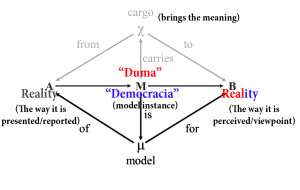
Figure 4
By applying Bernd Mahr’s Model theory in practice in the field of media, we give an answer to our research question: “To what extent the reality is a model for the media and to what extent the media themselves become a modelling instance, which constructs reality?”. From the conducted study, we can conclude that media are a model of reality, as they represents events and issues that have actually happened; they do not invent facts or nonexistent events. However, during the process of reporting and presenting the information, “packaging” it in a media product as articles, reports, etc., the media become a modelling instance that dictates the way the events in reality should be perceived and interpreted. In this way the media influence the opinions of their readers and lay the foundation for a certain model of thinking and perceiving of the events. Finally, our study shows that both newspapers Duma and Demokracia are media which report actual and real events. At the same time, they refract this real information according to the interests of the political party they serve and sympathize with. This creates prerequisites for influencing the society and politics in a certain direction.
Bibliography
в. Демокрация. Броеве: 8, 11, 19, 20 юни, 1990 г.
в. Дума. Броеве: 8, 11, 19, 20 юни, 1990 г.
Попова 2002: Попова, С. Социално време и медиен разказ – 1989-2000. София: ЛИК, 2002 г.
Dowling 2011: Dowling, W., D. Ricoeur on time and narrative. An introduction to Temps et récit. Notre Dame, Indiana: University of Notre Dame Press, 2011
Mahr 2011: Mahr, B. On the Epistemology of Models, Explaining the Nature of Models, What the Epistemology of Models Reveals; Еrschienen in: Günter Abel, James Conant (Hg): “Rethinking Epistemology, Volume 1”, Berlin, Boston: De Gruyter, 2011, 249–300.
Oxford Dictionary 2018, Definition of “model”. [visited on 6 March, 2018].
https://en.oxforddictionaries.com/definition/model.
Weiss, D’Mello 1997: Weiss, W., C. D’Mello. Fundamentals of Model Theory. Department of Mathematics: University of Toronto, 1997
За автора
Bistra Velichkova is a PhD student in the Faculty of Journalism and Mass Communication, at Sofia University St. Kliment Ohridski, Sofia, Bulgaria, under the supervision of Prof. Snejana Popova. In her doctoral research she investigates the relationship between journalism and literature in the period after the fall of Communism in Bulgaria (1989). More broadly, she is interested in the interplay between media reporting, fiction, memoirs and historical reality.
E-mail: bistra.velichkova@gmail.com
© Bistra Velichkova
Дата на публикация на статията: 05.07.2018 г.
__________________________________________________________________
© Международен филологически форум. Поредица към сп. “Филологически форум”, No 5, 2018
София: Факултет по славянски филологии, ISSN 2535-1354
